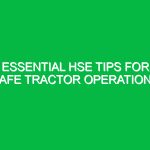Introduction
Hello team! Today, we are gathering for an important Toolbox Talk focused on a vital aspect of our daily operations: Unloading Trailers (Construction). As you all know, unloading trailers is part of our routine, yet it can pose significant risks if not done correctly. The aim of this discussion is to ensure we all understand the Best Practices, potential Hazards, and necessary Precautions involved in unloading trailers safely. By doing so, we can contribute to a safer work Environment for everyone.
The Importance of Safe Unloading
Unloading trailers is a common task on construction sites, but it is also one of the leading causes of workplace injuries. According to Safety statistics, improper unloading can lead to serious accidents, including falls, equipment damage, and even fatalities. By focusing on Safety during unloading, we not only protect ourselves but also our coworkers and the project as a whole.
Understanding the Risks
Before we delve into the Procedures, let’s take a moment to identify some potential Hazards associated with unloading trailers:
- Overexertion: Lifting heavy materials can lead to strains and sprains.
- Falling Objects: Unsecured items can fall off the trailer, posing risks to those nearby.
- Vehicle Movement: Other vehicles on site may pose a risk if drivers are unaware of unloading activities.
- Slips and Falls: Uneven terrain or wet surfaces can lead to slips while unloading.
Recognizing these risks is the first step in preventing accidents. Awareness allows us to take appropriate Precautions to safeguard ourselves and our teammates.
Best Practices for Unloading Trailers
Now that we understand the risks, let’s explore some Best Practices for safely unloading trailers:
1. Prepare the Area
Before unloading begins, ensure that the area is clear of unnecessary personnel and obstacles. This includes:
- Establishing a designated unloading zone.
- Ensuring the ground is stable and free of debris.
- Setting up warning signs or cones to alert others of unloading activities.
2. Inspect the Trailer
Always inspect the trailer before unloading. Look for:
- Signs of damage or instability.
- Secure tie-downs that may need to be loosened.
- Proper loading and weight distribution.
3. Use Appropriate Equipment
Utilize the right tools and equipment for unloading. This includes:
- Forklifts or pallet jacks for heavy materials.
- Straps and slings for securing loads.
- Personal protective equipment (PPE) such as gloves, hard hats, and steel-toed boots.
4. Communicate Effectively
Communication is key during unloading. Ensure everyone involved knows their role. Use clear signals or hand gestures if necessary, and always check in with your teammates.
5. Lift Properly
When lifting items manually, remember to:
- Keep your feet shoulder-width apart for balance.
- Bend at the knees, not at the waist.
- Keep the load close to your body.
- Use your legs to lift, not your back.
6. Watch for Falling Objects
Be aware of your surroundings and keep an eye on the load above you. If items are stacked high, ensure they are stable before unloading. If you notice anything precarious, alert your team.
7. Do Not Rush
Take your time when unloading. Rushing increases the likelihood of mistakes and accidents. Focus on doing the job right the first time to ensure everyone’s safety.
Real-Life Scenario
Let me share a hypothetical scenario to illustrate the importance of these practices:
Imagine a crew is unloading a trailer full of drywall sheets. They gather around, but there’s no clear communication. One worker starts loosening the straps while another is standing too close. Suddenly, a sheet slips and falls, narrowly missing the worker. If proper Precautions and communication had been in place, this close call could have been avoided. This scenario highlights how crucial it is to follow the best practices we discussed.
Regulations and Standards
As part of our commitment to safety, we must adhere to relevant Regulations and standards concerning unloading trailers. Familiarize yourself with:
- Occupational Safety and Health Administration (OSHA) guidelines.
- Company-specific safety policies.
- Industry standards for Manual Handling and equipment Operation.
Compliance is not just about following rules; it’s about protecting ourselves and our coworkers from harm. Failing to adhere to these regulations can result in serious consequences, including injuries and legal ramifications for the company.
Encouraging Team Engagement
Now, I’d like to hear from you. What experiences have you had with unloading trailers? Are there any challenges you’ve faced? Sharing these experiences can help us learn and improve our practices.
Additionally, if you have suggestions for improving our unloading procedures, please feel free to share. Your input is invaluable in creating a safer work environment.
Conclusion
In conclusion, today’s Toolbox Talk on Unloading Trailers (Construction) has emphasized the importance of safety in our daily operations. By recognizing hazards, following best practices, and adhering to regulations, we can significantly reduce the risk of accidents. Remember, safety is a collective responsibility, and by working together, we can maintain a safe workplace.
Thank you all for your attention and commitment to safety. Let’s carry these lessons into our work today and ensure we prioritize safety in every task we undertake. Stay safe out there!


